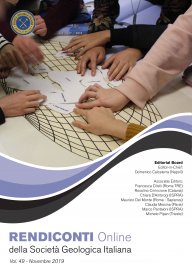

Superfici di interesse culturale geo-paleontologico con orme di dinosauro del Cretaceo (Albiano superiore): l'esempio di Lama Balice nella Città Metropolitana di Bari
Marco Petruzzelli (1), Stefano Cardia (1), Antonietta Cilumbriello (2), Ruggero Francescangeli (1), Rafael La Perna (1), Maria Marino (1), Antonella Marsico (1), Fabio Massimo Petti (1,3), Luisa Sabato (1,4), Luigi Spalluto (1), Eliana Stigliano (1) & Marcello Tropeano (1)
(1) Dipartimento di Scienze della Terra e GeoAmbientali, Università degli Studi di Bari Aldo Moro, via Orabona 4, 70125 Bari (Italy). (2) Genzano di Lucania (PZ) (Italy).
(3) MUSE - Museo delle Scienze, Corso del Lavoro e della Scienza 3, 38122 Trento (Italy).
(4) Dipartimento di Biologia, Università degli Studi di Bari Aldo Moro, via Orabona 4, 70125 Bari (Italy).
Corresponding author e-mail: luisa.sabato@uniba.it
Volume: 49/2019
Pages: 157-168
Abstract
Along the eastern flank of the Murge, a karst plateu located in Apulia (southern Italy), the “Parco Naturale Regionale Lama Balice” (“Lama Balice” Regional Natural Park), which falls into the Metropolitan City of Bari, was established; in the Park, on a bottom surface of an abandoned quarry, several dinosaur footprints were found. The quarry develops in the Cretaceous limestones of the Calcare di Bari Fm, and shows an about 20 m thick upper Albian succession made up of carbonates and dolomites. A Research Convention stipulated between the Park authority, the University of Bari and the “Soprintendenza Archeologia, Belle Arti e Paesaggio per la Città Metropolitana di Bari”, allowed the access to the quarry and the study of both the stratigraphic succession and the trumpled surface.
In order to investigate the outcropping succession, a stratigraphic log was realised, and 54 samples were collected. Thin sections were produced and a facies analysis was carried out by means of macroscopic feature observations and microscopic ones. Several facies were recognised allowing to attribute the studied succession to a tidal flat frequently subject to prolonged subaerial exposure. The study of the surface consisted both in an ichnological analysis of individual footprints and in the identification of potential trackways. In order to highlight the main morphological features of footprints, an ichnological survey was realised by means of interpretative drawings carried out directly in situ. Then, data were processed digitally through photos and photomosaics. The best-preserved footprints allowed us to recognize the presence of theropods, ankylosaurs, and probably sauropods. All the recognized taxa belong to small- to medium-sized dinosaurs.
The presence of dinosaur footprints represents an important contribute to the knowledge of Cretaceous paleoenvironments of this sector of the Apulia Carbonate Platform corresponding to the Murge region.
Interestingly, the occurrence of dinosaur footprints within a park area, located close to a large city and an airport, represents a powerful educational and cultural tool.
Keywords
Get Full Text